The Glass Web — 3-D
Universal’s second 3-D picture of the classic era has an edge on its competition: direction that takes full advantage of the depth effect in almost every shot. It’s not a bad whodunnit, either, with Edward G. Robinson in a tailor-made part and John Forsythe sweating out the hours as an innocent man framed by his own foolish decisions. Director Jack Arnold applies himself to the possibilities of 3-D, coming up with one of the more pleasing entries in the short-lived fad. Of special note is actress Kathleen Hughes, the center of attention in the cleverly scripted suspense picture.

The Glass Web 3-D
3-D Blu-ray
KL Studio Classics
1953 / B&W / 1:85 / 81 min. / Spin the Glass Web / Street Date March 25, 2025 / Available at Kino Lorber /
Starring: Edward G. Robinson, John Forsythe, Kathleen Hughes, Marcia Henderson, Richard Denning, Hugh Sanders, Jean Willes, Eve McVeagh, Harry Tyler, John Hiestand, Clark Howat, Robert Nelson, John Verros, Helen Wallace, Benny Rubin, Paul Dubov, Kathleen Freeman, Lance Fuller, Beverly Garland, Brett Halsey, Jack Kelly.
Cinematography: Maury Gertsman
Visual Effects: David S. Horsley
Dialogue Director: Irvin Berwick
Art Directors: Bernard Herzbrun, Eric Orbom
Costumes: Bill Thomas
Film Editor: Ted J. Kent
Screenplay by Robert Blees, Leonard Lee from the novel by Max Erlich
Produced by Albert J. Cohen
Directed by Jack Arnold
 Hollywood went nuts in reaction to Arch Oboler’s 3-D Bwana Devil. Shooting ‘depth’ pictures wasn’t easy, as the process used twice as much film stock and required more production time for the camera crew. But for two years the town went nuts on the process. More than 50 features were produced, although the fad imploded so quickly, many weren’t given a full release in 3-D.
Hollywood went nuts in reaction to Arch Oboler’s 3-D Bwana Devil. Shooting ‘depth’ pictures wasn’t easy, as the process used twice as much film stock and required more production time for the camera crew. But for two years the town went nuts on the process. More than 50 features were produced, although the fad imploded so quickly, many weren’t given a full release in 3-D.
Universal’s 1953 murder thriller The Glass Web followed the studio’s It Came from Outer Space into theaters. It arrived late in 1953, three months before Alfred Hitchcock’s color 3-D murder classic Dial M for Murder. But just one year after the debut of Bwana Devil, theaters were balking at showing 3-D pix, and studios were choosing to curtail 3-D bookings or in some cases, cancel them entirely. The fade-out on the process’es popularity was blamed on inconsistent projection and exhibitor complaints, but it’s likely that audiences soon realized that 3-D couldn’t make a bad movie good. The Glass Web balances things well: it plays on its own merits and the 3-D adds significant appeal.
72 years and a million ‘clever’ murder scenarios later, The Glass Web shapes up as a reasonably intelligent thriller that doesn’t give away all its secrets in the first five minutes. Therefore our synopsis will tread lightly:
TV writer Don Newell (John Forsythe) has a promising but low-paying job writing for Crime of the Week, a live TV show purporting to recount ‘true life’ murders in accurate detail. Don gets along with his producer-director Dave Markson (Richard Denning) but is being scolded by casting director / researcher Henry Hayes (Edward G. Robinson) for skipping details that Hayes feels crime fans want to see. Don finds himself in hot water when the ambitious starlet Paula Ranier (Kathleen Hughes) works a blackmail scheme on him. Don had bowed out of his extramarital affair with Paula some time ago, but now she wants 2500 dollars in exchange for some evidence that would end his marriage to his loyal wife Louise (Marcia Henderson). Don can barely concentrate on his work. He’s unaware that Paula has done this before. She is presently stalling a hot-to-trot Henry Hayes, while taking his ‘gifts.’ Paula is separated from her husband, Jeff (John Verros), a criminal. Jeff’s in town, but Paula wants nothing to do with him.
When a murder occurs, Don finds himself in a sticky situation. His behaviors will easily make him a prime suspect for homicide detective Mike Stevens (Hugh Sanders). Then the worst possible thing occurs — Dave Markson approves the Paula Ranier murder to serve as the next Crime of the Week story, even though it hasn’t been solved. Henry Hayes chose the subject, and is scheming to take Don’s job. He’s writing his own script behind Don’s back — and is collecting ‘crime details’ that pin the murder on Don.
The Glass Web begins with some of the best direction in Jack Arnold’s career. A grisly murder scene is revealed to be a live performance of a Crime of the Week show. Several years later director John Frankenheimer would use a live TV setting to fashion docu-real suspense in The Manchurian Candidate, but Robert Blees & Leonard Lee’s screenplay plays with a similar clash between fictional TV ‘reality’ and the real thing. In the first shot, Arnold’s camera snakes through the scene, revealing what’s going on in a long pullback that eventually shows the TV crew at work. Moments later, Arnold maintains spatial integrity (in a 3-D space) with another extended shot that shifts to several different positions in the TV studio’s busy backstage action.
A flashback explains Don Newell’s illicit affair, that reveals Paula as a greedy opportunist. She’s a tough cookie, fleecing Edward G. Robinson’s sympathetic middle-aged sucker. The gullible Henry allows himself to be teased and abused by the object of his affections. The character is tailored to Robinson’s screen persona. He has a a police background, and perceives from the get-go that something was cooking between Don and Paula.
None of this is very subtle, but neither is it transparently obvious. John Forsythe’s Don makes one ‘homicidal boo boo’ after another, leaving clues that any decent investigation should uncover. His behavior on the day of the murder disturbs his wife and his co-workers. Several strangers near the crime scene, including a cop on the beat would all say, ‘Yeah, there was this guy there who acted really strangely…’
John Forsythe had been in movies for ten years but had only scored a couple of leading roles in features. He is the leading man here, even though Edward G. Robinson gets top billing. Robinson was gray-listed from major studio work, remaining a star but taking whatever smaller pictures were on offer. The script gives Robinson’s Henry Hayes several key scenes but not a lot of screen time. The great actor dominates the movie but probably didn’t get that many days’ work from it.

Forsythe can carry the picture well enough; the problem is that his Don Newell is not a nice person we can root for. He’s a blackmail victim but also a spineless husband who let a pretty face threaten his home life. Don’s kid leaves cheerful, admiring notes for him: ‘Have a great show, Dad!’
Marcia Henderson has the thankless part of the understanding wife. The plum role goes to fan favorite Kathleen Hughes, → a beauty with a knowing look, who invests the scheming Paula with a good measure of credibility. Paula plays the soft ‘n’ fuzzy bon-bon for Henry and Don, and then laughs in their faces when she has them under her greedy control. She really has it in for these guys. The writers may have wanted to replay Edward G. Robinson’s classic cuckold scene from Fritz Lang’s Scarlet Street, where his noir loser can no longer take Joan Bennett’s emasculating jeers.

Kathleen Hughes is now most remembered for the Science Fiction movie It Came from Outer Space, despite her fairly insignificant role therein. Universal gave her a significant promotional push, not for her acting ability but for her status as ‘Miss 3-D.’ Advertising for both pictures suggested that audiences would get the full depth effect of Ms. Hughes’ figure. The Glass Web’s ads featured the actress reclining on the floor as if posing for the then-new Playboy magazine. But in Hollywood of 1953 ‘billing in a box’ was not something an actor would turn down, in any circumstances.
The show works its way to what was a fairly fresh conclusion for 1953. The killer has the common bad habit of picking the wrong time to explain his crime at length. He blabs to his prospective victims when he should be shooting them and rearranging things to suggest a suicide. Good cross-cutting keeps the scene on its feet.
The 3-D looks superb throughout. Just before the intermission break, Arnold adds a bit on the street with four or five excellent ‘paddleball’ gags in a row — vehicles, thrown items, etc., are shoved into our faces in 3-D. English critics called them ‘pelt and burn’ effects. The rest of the movie avoids showeoff gags and instead immerses us in a 3-D ‘continuum.’ A simple medium shot of Eddie G., feels dimensional because he has one hand naturally raised, slightly, toward the camera. A gag with a lighting change is very successful — just when Paula has Don trapped on her couch, her cat Marco (Orangey aka Rhubarb) pulls out a power cord, putting them in a dramatic ‘depth silhouette.’ We hope Kathleen Hughes received extra stunt pay — it’s definitely her playing the victim on the TV show, hanging limp as she’s dropped down a mine shaft.
It was also progressive in 1963 to see the crime recreated on the TV show, as ‘reality TV’ that indeed helps identify the killer. We suspect that the TV show’s apartment set is the same set used for the actual murder. Paul Dubov and Jean Willes play TV actors substituting for the ‘real’ people. Earlier on, Beverly Garland appears as an inebriated party guest, un-billed. And we are always pleased to see favorite Kathleen Freeman getting such a big part … also without screen credit.
KL Studio Classics’ 3-D Blu-ray of The Glass Web shapes ups as a solid 3-D feature, one that shows off the process better than most. The B&W values are good at all times, and the depth effect in the widescreen format is excellent. The 3-D Film Archive must have found that Universal’s left & right eye printing elements were well-preserved.
Rear-projection in a car driving down Pacific Coast Highway looks superb … do they cross the intersection with Sunset Blvd.? Optical effects expert David Horsley would seem to be the creator of a pair of matte shots that place Robinson and Forsythe on a cliff overlooking the Pacific. It must have been a challenge to figure out the optical work in 3-D. Rotoscope mattes animate around a moving automobile and the human figures, quite nicely.

The only video extras are a surviving TV spot and trailer. But an excellent audio commentary features author and academic Jason A. Ney, who wastes no time offering a detailed account of the production and a thoughtful analysis of its place in 3-D history. We also get a lot of insight about the way TV ownership exploded in the early 1950s. Mike Ballew and Greg Kintz step in with more 3-D history and technical detail talk.
In addition to Kintz and Ballew, a nice audio clip gives us Alan K. Rode Rode interviewing actress Kathleen Hughes after a film screening a number of years ago. She explains how she became Universal’s ‘3-D Girl,’ and her pleasant working experience with Edward G. Robinson. Ney confirms what we think watching the movie, that Universal was trying to position Ms. Hughes as a substitute Marilyn Monroe.
Jason Ney saves the last twenty minutes for two very good speeches. The first is a thorough indictment of director Jack Arnold’s predatory sexual behavior. Scores of memoirs have explained how Arnold aggressively came on to his actresses and many other women working at the studios. Ney then gives a fine, detailed defense of the patriotic Edward G. Robinson’s years-long battle to clear his name when unjustly accused during the HUAC years.
Viewers without Polaroid 3-D Blu-ray setups need not despair, as a red/blue anaglyphic 3-D encoding of the film is present. And as I always forget to say on these discs, the show can be viewed in normal 2-D as well.
Reviewed by Glenn Erickson

The Glass Web 3-D
Blu-ray rates:
Movie: Very Good
Video: Excellent
Sound: Excellent
Supplements:
Audio commentary with Jason A. Ney, with Mike Ballew and Greg Kintz
Original trailer and TV spot
Anaglypic Red / Blue 3-D encoding with a pair of anaglyphic glasses.
Deaf and Hearing-impaired Friendly? Subtitles: English (feature only)
Packaging: One Blu-ray in Keep case
Reviewed: March 6, 2025
(7289web)
Visit CineSavant’s Main Column Page
Glenn Erickson answers most reader mail: cinesavant@gmail.com
Text © Copyright 2025 Glenn Erickson






